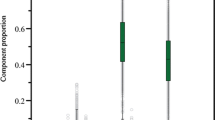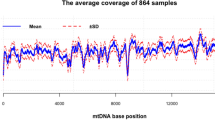Abstract
Mitochondrial DNA (mtDNA) haplogroups are valuable for investigations in forensic science, molecular anthropology, and human genetics. In this study, we developed a custom panel of 61 mtDNA markers for high-throughput classification of European, African, and Native American/Asian mitochondrial haplogroup lineages. Using these mtDNA markers, we constructed a mitochondrial haplogroup classification tree and classified 18,832 participants from the National Health and Nutrition Examination Surveys (NHANES). To our knowledge, this is the largest study to date characterizing mitochondrial haplogroups in a population-based sample from the United States, and the first study characterizing mitochondrial haplogroup distributions in self-identified Mexican Americans separately from Hispanic Americans of other descent. We observed clear differences in the distribution of maternal genetic ancestry consistent with proposed admixture models for these subpopulations, underscoring the genetic heterogeneity of the United States Hispanic population. The mitochondrial haplogroup distributions in the other self-identified racial/ethnic groups within NHANES were largely comparable to previous studies. Mitochondrial haplogroup classification was highly concordant with self-identified race/ethnicity (SIRE) in non-Hispanic whites (94.8 %), but was considerably lower in admixed populations including non-Hispanic blacks (88.3 %), Mexican Americans (81.8 %), and other Hispanics (61.6 %), suggesting SIRE does not accurately reflect maternal genetic ancestry, particularly in populations with greater proportions of admixture. Thus, it is important to consider inconsistencies between SIRE and genetic ancestry when performing genetic association studies. The mitochondrial haplogroup data that we have generated, coupled with the epidemiologic variables in NHANES, is a valuable resource for future studies investigating the contribution of mtDNA variation to human health and disease.



Similar content being viewed by others
References
Alcolado JC, Alcolado R (1991) Importance of maternal history of non-insulin dependent diabetic patients. BMJ 302:1178–1180
Allard MW, Miller K, Wilson M, Monson K, Budowle B (2002) Characterization of the Caucasian haplogroups present in the SWGDAM forensic mtDNA dataset for 1771 human control region sequences. Scientific Working Group on DNA Analysis Methods. J Forensic Sci 47:1215–1223
Allard MW, Polanskey D, Miller K, Wilson MR, Monson KL, Budowle B (2005) Characterization of human control region sequences of the African American SWGDAM forensic mtDNA data set. Forensic Sci Int 148:169–179
Allard MW, Polanskey D, Wilson MR, Monson KL, Budowle B (2006) Evaluation of variation in control region sequences for Hispanic individuals in the SWGDAM mtDNA data set. J Forensic Sci 51:566–573
Alleman BW, Myking S, Ryckman KK, Myhre R, Feingold E, Feenstra B, Geller F, Boyd HA, Shaffer JR, Zhang Q, Begum F, Crosslin D et al (2012) No observed association for mitochondrial SNPs with preterm delivery and related outcomes. Pediatr Res 72:539–544
Bertoni B, Budowle B, Sans M, Barton S, Chakraborty R (2003) Admixture in Hispanics: distribution of ancestral population contributions in the Continental United States. Hum Biol 75:1–11
Canter JA, Kallianpur AR, Parl FF, Millikan RC (2005) Mitochondrial DNA G10398A polymorphism and invasive breast cancer in African-American women. Cancer Res 65:8028–8033
Crispim D, Canani LH, Gross JL, Tschiedel B, Souto KEP, Roisenberg I (2006) The European-specific mitochondrial cluster J/T could confer an increased risk of insulin-resistance and type 2 diabetes: an analysis of the m.4216T>C and m.4917A>G variants. Ann Hum Genet 70:488–495
Forster P (2004) Ice Ages and the mitochondrial DNA chronology of human dispersals: a review. Philos Trans R Soc B Biol Sci 359:255–264
Hanis CL, Hewett-Emmett D, Bertin TK, Schull WJ (1991) Origins of U.S. Hispanics. Implications for diabetes. Diabetes Care 14:618–627
Herrnstadt C, Elson JL, Fahy E, Preston G, Turnbull DM, Anderson C, Ghosh SS, Olefsky JM, Beal MF, Davis RE, Howell N (2002) Reduced-median-network analysis of complete mitochondrial DNA coding-region sequences for the major African, Asian, and European haplogroups. Am J Hum Genet 70:1152–1171
Kenney MC, Hertzog D, Chak G, Atilano SR, Khatibi N, Soe K, Nobe A, Yang E, Chwa M, Zhu F, Memarzadeh M, King J et al (2013) Mitochondrial DNA haplogroups confer differences in risk for age-related macular degeneration: a case control study. BMC Med Genet 14:4
Kumar S, Bellis C, Zlojutro M, Melton PE, Blangero J, Curran JE (2011) Large scale mitochondrial sequencing in Mexican Americans suggests a reappraisal of Native American origins. BMC Evol Biol 11:293
Levran O, Awolesi O, Shen P-H, Adelson M, Kreek MJ (2012) Estimating ancestral proportions in a multi-ethnic US sample: implications for studies of admixed populations. Hum Genomics 6:2
Merriwether DA, Huston S, Iyengar S, Hamman R, Norris JM, Shetterly SM, Kamboh MI, Ferrell RE (1997) Mitochondrial versus nuclear admixture estimates demonstrate a past history of directional mating. Am J Phys Anthropol 102:153–159
Paneto GG, Köhnemann S, Martins JA, Cicarelli RMB, Pfeiffer H (2011) A single multiplex PCR and SNaPshot minisequencing reaction of 42 SNPs to classify admixture populations into mitochondrial DNA haplogroups. Mitochondrion 11:296–302
Poole JC, Procaccio V, Brandon MC, Merrick G, Wallace DC (2010) Multiplex analysis of mitochondrial DNA pathogenic and polymorphic sequence variants. Biol Chem 391:1115–1130
Soini HK, Moilanen JS, Finnila S, Majamaa K (2012) Mitochondrial DNA sequence variation in Finnish patients with matrilineal diabetes mellitus. BMC Res Notes 5:350
Tang K, Oeth P, Kammerer S, Denissenko MF, Ekblom J, Jurinke C, van den Boom D, Braun A, Cantor CR (2004) Mining disease susceptibility genes through SNP analyses and expression profiling using MALDI-TOF mass spectrometry. J Proteome Res 3:218–227
Tang D-L, Zhou X, Li X, Zhao L, Liu F (2006) Variation of mitochondrial gene and the association with type 2 diabetes mellitus in a Chinese population. Diabetes Res Clin Pract 73:77–82
Thomas F, Balkau B, Vauzelle-Kervroedan F, Papoz L (1994) Maternal effect and familial aggregation in NIDDM. The CODIAB Study. CODIAB-INSERM-ZENECA Study Group. Diabetes 43:63–67
van der Walt JM, Nicodemus KK, Martin ER, Scott WK, Nance MA, Watts RL, Hubble JP, Haines JL, Koller WC, Lyons K, Pahwa R, Stern MB et al (2003) Mitochondrial polymorphisms significantly reduce the risk of Parkinson disease. Am J Hum Genet 72:804–811
van der Walt JM, Dementieva YA, Martin ER, Scott WK, Nicodemus KK, Kroner CC, Welsh-Bohmer KA, Saunders AM, Roses AD, Small GW, Schmechel DE, Murali Doraiswamy P et al (2004) Analysis of European mitochondrial haplogroups with Alzheimer disease risk. Neurosci Lett 365:28–32
van Oven M, Kayser M (2009) Updated comprehensive phylogenetic tree of global human mitochondrial DNA variation. Hum Mutat 30:E386–E394
Wallace DC (2012) Mitochondria and cancer. Nat Rev Cancer 12:685–698
Wallace DC (2013) Bioenergetics in human evolution and disease: implications for the origins of biological complexity and the missing genetic variation of common diseases. Philos Trans R Soc B Biol Sci 368(1622):20120267
Wang D, Taniyama M, Suzuki Y, Katagiri T, Ban Y (2001) Association of the mitochondrial DNA 5178A/C polymorphism with maternal inheritance and onset of type 2 diabetes in Japanese patients. Exp Clin Endocrinol Diabetes Off J Ger Soc Endocrinol Ger Diabetes Assoc 109:361–364
Young CA, Kumar S, Young MJ, Boulton AJM (1995) Excess maternal history of diabetes in Caucasian and Afro-origin non-insulin-dependent diabetic patients suggests dominant maternal factors in disease transmission. Diabetes Res Clin Pract 28:47–49
Zheng S, Qian P, Li F, Qian G, Wang C, Wu G, Li Q, Chen Y, Li J, Li H, He B, Ji F (2012) Association of mitochondrial DNA variations with lung cancer risk in a Han Chinese population from southwestern China. PLoS One 7:e31322
Acknowledgments
Genotyping in NHANES was supported in part by the Epidemiologic Architecture for Genes Linked to Environment (EAGLE) study (U01HG004798 and its ARRA supplements) as part of the Population Architecture using Genomics and Epidemiology (PAGE) study established by the National Human Genome Research Institute (NHGRI). We at EAGLE would like to thank Melissa Allen and Paxton Baker for their work in genotyping the samples through the Center for Human Genetic Research Open Wet Lab (OWL) and DNA Resources Core, respectively. We would also like to thank Dr. Geraldine McQuillan and Jody McLean for their help in accessing the Genetic NHANES data. The Vanderbilt University Center for Human Genetics Research, Computational Genomics Core provided computational and/or analytical support for this work. The findings and conclusions in this report are those of the authors and do not necessarily represent the views of the National Institutes for Health or the Centers for Disease Control and Prevention.
Author information
Authors and Affiliations
Corresponding author
Electronic supplementary material
Below is the link to the electronic supplementary material.
Rights and permissions
About this article
Cite this article
Mitchell, S.L., Goodloe, R., Brown-Gentry, K. et al. Characterization of mitochondrial haplogroups in a large population-based sample from the United States. Hum Genet 133, 861–868 (2014). https://doi.org/10.1007/s00439-014-1421-9
Received:
Accepted:
Published:
Issue Date:
DOI: https://doi.org/10.1007/s00439-014-1421-9




